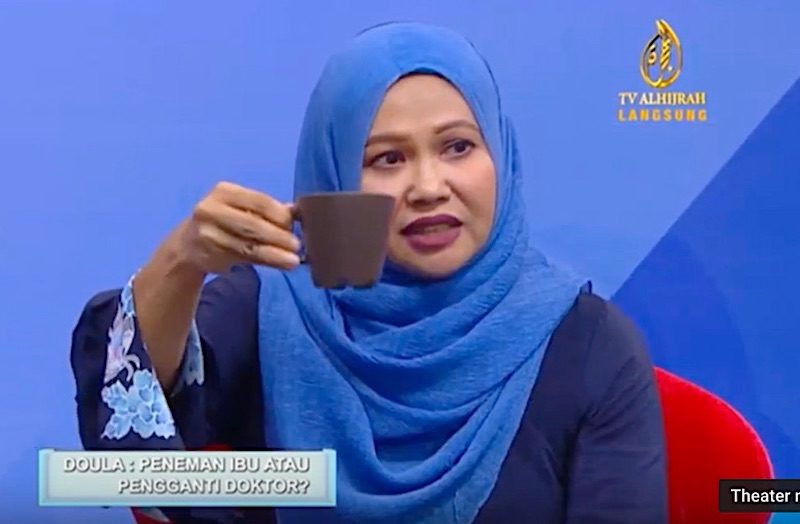I watched with great interest (and amusement) the session between two panelists, Prof. Dr. Imelda Balchin (Professor and O&G Specialist) and Puan Hayati Muzaffar (Freelance Doula). Luckily I could catch the 10 pm session by @analisis.tvalhijrah over their youtube livecast. You can watch the entire session here.
The first thing I learned from this session: A doula is not a midwife.
A doula provides emotional, physical and educational (including spiritual) support for the pregnant lady and family during and after a birth; whereas a midwife is a medically-trained person who assists the delivery and wellbeing of the mother and the child.
Doulas, in the UK, US and Australia, receive proper training, are recognised and belong to a doula association. Unfortunately in Malaysia, the practice has yet come to this level… **
In this post, I would like to share 3 presentation takeaways or lessons, gleaned from the lively session, on:
- body language.
- the power of visuals.
- visual analogy.
Just in case you’ll be invited to present on the telly, read on 😉
1. Body language: No Ultraman pose please…
In this instance, Prof. Imelda asked for the third time, is doula training in Malaysia being certified by Malaysia Ministry of Health (KKM)? It’s a yes or no answer. However, doula Hayati didn’t and couldn’t give a straight answer. The next thing the audience saw in a split-second was the pose shown in the screen shot below (min 24.40-48).

Takeaway: To a closed-ended question, just answer Yes or No. Explain or defend your answer in a succinct manner, right after that (if you feel it needs justifications). Don’t try to strike a pose like an Ultraman, even if you are unable to counter the other person’s arguments or questions.
It’s a serious, intellectual topic on safety of mothers and babies during delivery. It’s also being hosted in a formal setting. And that pose was seen by thousands of Malaysians (Oh dear…).
2. The power of visuals: Clarity
Prof. Imelda came well-prepared. And she used simple images, screen captures (news) and short animations to illustrate her points.
Before this panel session, I read some blog and FB posts on doula in Malaysia, including cases of deaths (mothers and babies). Several cited severe complications and blood loss (haemorrhage) due to placenta (uri in Malay), that are beyond what doulas are trained for. Or rather, they are untrained for.

But it wasn’t clear to me why until Prof. Imelda explained that the main cause of deaths during child delivery is blood loss (min. ~30-33). Typically, doctors would undertake an active management during child delivery by, first, injecting a drug to the mother (to shrink the uterus) in order to reduce continual bleeding (see No. 3 below). Second, doctors would clamp the cord and third, remove the placenta. All these would result in 50% reduction of blood loss in mothers, after birth.
Takeaway: Giving birth is a complex process, but Prof. Imelda explained the purposes of each procedure, step-by-step, in a clear and succinct manner. In just under 3 minutes with the help of the animations. Plus, she used a lot of hand gestures at the right moments to emphasise her points.
3. Visual analogy: 3 cups a minute
Even after giving birth, a placenta continues to receive blood supply. To make her point more concrete and relatable to the public, Prof. Imelda held her cup up to the camera and for the audience to see. She said, a mother continues to lose 800 ml of blood a minute. This cup holds about 250 ml. So, a mother is losing about 3 cups a minute (3 cawan seminit).
Now that’s a LOT of blood. Let alone blood loss. Per minute.

Okay… now imagine, if an untrained person leaves a mother bleeding over 30 minutes. Simply because the person is not trained in detecting a medical emergency or complications. How many cups of blood the poor mother loses? How many 1 litre jugs of blood? You do the math.
A life is precious. Two lives?**
Takeaway: Find an everyday item to demonstrate your concepts or ideas. Check out this nice example of sugar content of popular drinks, which shows the amount of sugar in a normal canned drink (330 ml).
Somehow, the rule of three is used often in Prof. Imelda’s talk (3 questions on doula training, 3 steps, 3 cups…). I wrote about the rule of three in Elevate and how it has helped in my planning and delivery of winning presentations.
I believe the use of a simple visual analogy is perhaps one single thing that separates a great presenter from a mediocre one.
Overall, I think doula Hayati’s way of answering questions improved over time. Early on she was quite evasive and didn’t answer questions. In time, she looked a bit more settled; she was able to articulate her ideas better towards the end of the session. Prof. Imelda is the top O&G expert in Malaysia who spoke with clarity, confidence and elegance. She spoke from the depth of her knowledge and vast experience. And she spoke from her (power) centre. Hats off to her! =)
*The closest English translation of the title (I could think of) – Doula: A Mother’s Companion or a Doctor’s Replacement?
** I must say that, this is a huge tragedy. And not just one tragedy… No one seems to want to regulate these people or take responsibility over the deaths. Perhaps, please consider increasing the number of staff (doctors, nurses) in hospitals to give good care for mothers and babies, including the over-worked staff.
